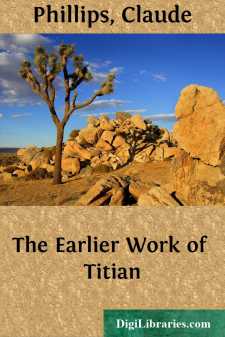Categories
- Antiques & Collectibles 13
- Architecture 36
- Art 48
- Bibles 22
- Biography & Autobiography 813
- Body, Mind & Spirit 142
- Business & Economics 28
- Children's Books 15
- Children's Fiction 12
- Computers 4
- Cooking 94
- Crafts & Hobbies 4
- Drama 346
- Education 46
- Family & Relationships 57
- Fiction 11828
- Games 19
- Gardening 17
- Health & Fitness 34
- History 1377
- House & Home 1
- Humor 147
- Juvenile Fiction 1873
- Juvenile Nonfiction 202
- Language Arts & Disciplines 88
- Law 16
- Literary Collections 686
- Literary Criticism 179
- Mathematics 13
- Medical 41
- Music 40
- Nature 179
- Non-Classifiable 1768
- Performing Arts 7
- Periodicals 1453
- Philosophy 64
- Photography 2
- Poetry 896
- Political Science 203
- Psychology 42
- Reference 154
- Religion 513
- Science 126
- Self-Help 84
- Social Science 81
- Sports & Recreation 34
- Study Aids 3
- Technology & Engineering 59
- Transportation 23
- Travel 463
- True Crime 29
The Earlier Work of Titian
by: Claude Phillips
Description:
Excerpt
CHAPTER I
Cadore and Venice—Early Giorgionesque works up to the date of the residence in Padua—New interpretations of Giorgione's and Titian's pictures.
Tiziano Vecelli was born in or about the year 1477 at Pieve di Cadore, a district of the southern Tyrol then belonging to the Republic of Venice, and still within the Italian frontier. He was the son of Gregorio di Conte Vecelli by his wife Lucia, his father being descended from an ancient family of the name of Guecello (or Vecellio), established in the valley of Cadore. An ancestor, Ser Guecello di Tommasro da Pozzale, had been elected Podesta of Cadore as far back as 1321. The name Tiziano would appear to have been a traditional one in the family. Among others we find a contemporary Tiziano Vecelli, who is a lawyer of note concerned in the administration of Cadore, keeping up a kind of obsequious friendship with his famous cousin at Venice. The Tizianello who, in 1622, dedicated to the Countess of Arundel an anonymous Life of Titian known as Tizianello's Anonimo, and died at Venice in 1650, was Titian's cousin thrice removed.
Gregorio Vecelli was a valiant soldier, distinguished for his bravery in the field and his wisdom in the council of Cadore, but not, it may be assumed, possessed of wealth or, in a poor mountain district like Cadore, endowed with the means of obtaining it. The other offspring of the marriage with Lucia were Francesco,—supposed, though without substantial proof, to have been older than his brother,—Caterina, and Orsa. At the age of nine, according to Dolce in the Dialogo della Pittura, or of ten, according to Tizianello's Anonimo, Titian was taken from Cadore to Venice, there to enter upon the serious study of painting. Whether he had previously received some slight tuition in the rudiments of the art, or had only shown a natural inclination to become a painter, cannot be ascertained with any precision; nor is the point, indeed, one of any real importance. What is much more vital in our study of the master's life-work is to ascertain how far the scenery of his native Cadore left a permanent impress on his landscape art, and in what way his descent from a family of mountaineers and soldiers, hardy, yet of a certain birth and breeding, contributed to shape his individuality in its development to maturity. It has been almost universally assumed that Titian throughout his career made use of the mountain scenery of Cadore in the backgrounds to his pictures; and yet, if we except the great Battle of Cadore itself (now known only in Fontana's print, in a reduced version of part of the composition to be found at the Uffizi, and in a drawing of Rubens at the Albertina), this is only true in a modified sense. Undoubtedly, both in the backgrounds to altar-pieces, Holy Families, and Sacred Conversations, and in the landscape drawings of the type so freely copied and adapted by Domenico Campagnola, we find the jagged, naked peaks of the Dolomites aspiring to the heavens. In the majority of instances, however, the middle distance and foreground to these is not the scenery of the higher Alps, with its abrupt contrasts, its monotonous vesture of fir or pine forests clothing the mountain sides, and its relatively harsh and cold colouring, but the richer vegetation of the Friulan mountains in their lower slopes, or of the beautiful hills bordering upon the overflowing richness of the Venetian plain. Here the painter found greater variety, greater softness in the play of light, and a richness more suitable to the character of Venetian art. All these tracts of country, as well as the more grandiose scenery of his native Cadore itself, he had the amplest opportunities for studying in the course of his many journeyings from Venice to Pieve and back, as well as in his shorter expeditions on the Venetian mainland....



